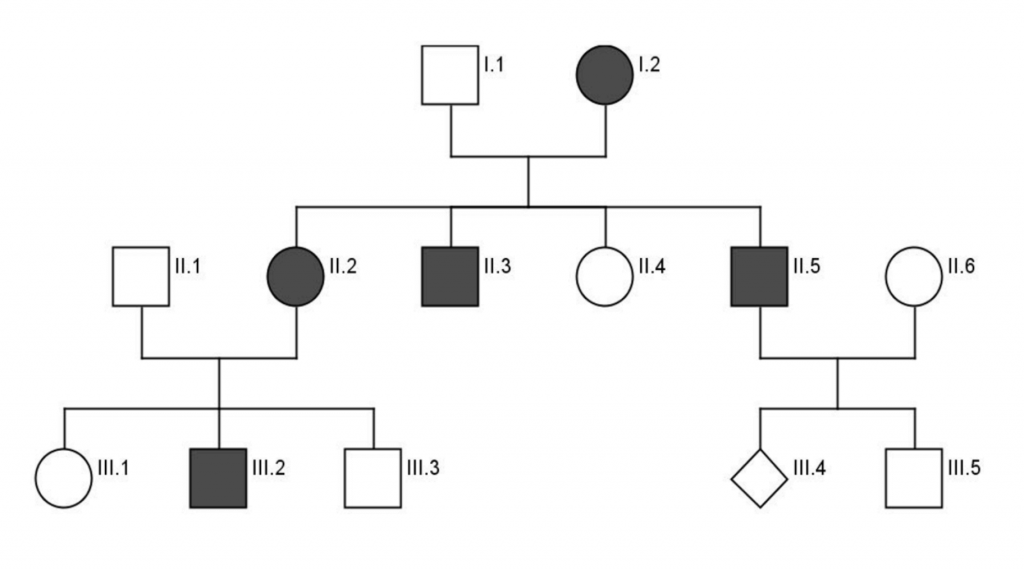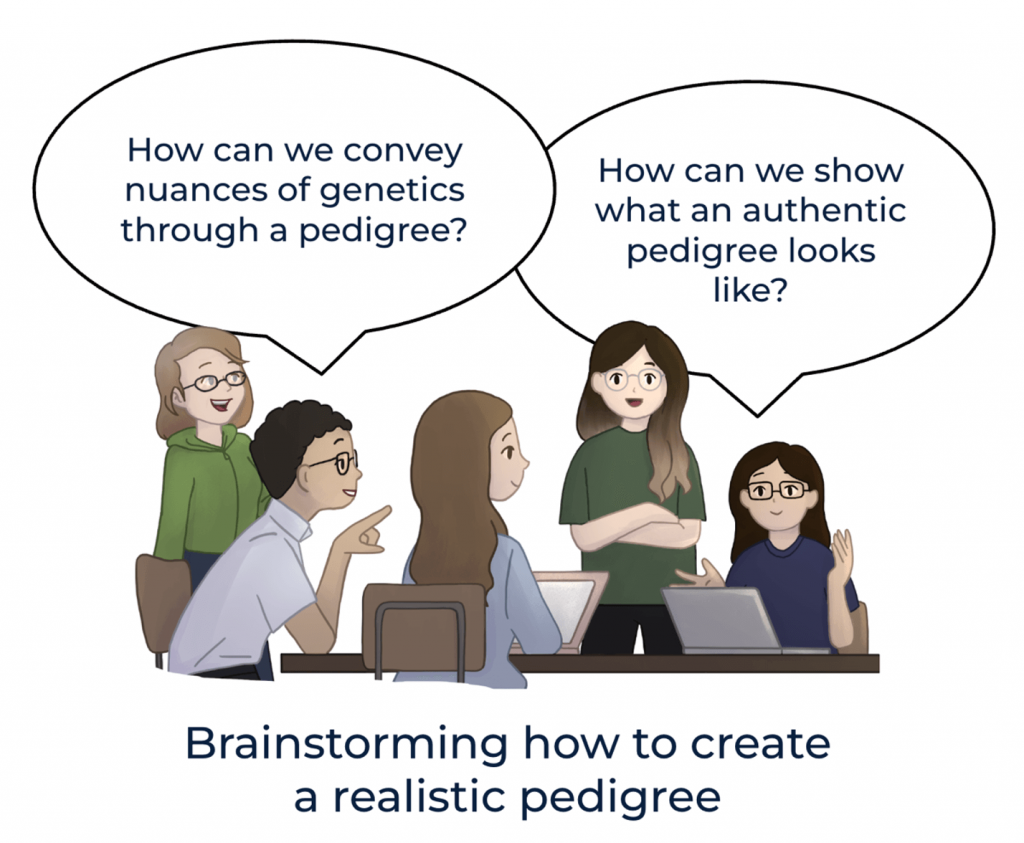
A student-directed education research team led by Pam Kalas set out to “de-simplify” genetics by creating an interactive case study that engages students in analyzing an authentic pedigree to better understand the complexity and nuance underlying genetic traits.
Below, team members Ahmad and Si-ah recount their journey, offering insights into the key questions, challenges, opportunities, and discoveries that shaped their research and development process.
Tell us about yourselves!
Hi! Our names are Ahmad and Si-ah. We have recently been working on educational research that targets how genetics is taught at the undergraduate level. Ahmad is currently in his third year of Integrated Sciences and Si-ah graduated last May with an Honours in Behavioural Neuroscience!
How did this all start—and why did you want to change how genetics is taught?
We like to think it started with a scribbled pedigree on a whiteboard and a lot of “wait… but what if?” questions. But really, it started even earlier in first year, in our Science One biology course, where we were introduced to case studies. Whether it was about hemophilia or pepper plants, those activities and discussions didn’t just have simple answers. They encouraged rigorous thinking and constant questioning.
As students in the Science One program, we were encouraged to question everything, including how we were learning. We started to see the limits of having clear-cut answers and absolute truths in education. We constantly asked ourselves, “how can education and assessment be changed so that creativity is rewarded rather than punished?”
That mindset stuck with us. Later, we became TAs in the same course, and one day, Dr. Pamela Kalas asked us if we wanted to help out with some teaching materials. At the time, we had no idea what that would actually look like. We just thought case studies were cool, thanks to our fellow students Ria Goel and Andrea Jackman who had developed the case study on hemophilia. We were also excited by the idea of contributing to something that could challenge common misconceptions in genetics.
When did you start developing the activity, and how did colour vision deficiency come into play?
In the summer of 2024, Ahmad started looking more closely at colour vision deficiency (CVD). It’s relatively common, making it a great example to explore how “affected” versus “unaffected” categories aren’t always clear-cut. We recognized that categorization often relies on thresholds that, while presented as objective, are shaped by subjective criteria. How strong or weak does someone’s sensitivity to red colour need to be before we consider them “affected”? And who decides?
That’s where the idea of a top-down, narrative-based pedigree activity came from. We wanted students to start with something that looked familiar, a classic pedigree, and then realize that things aren’t always what they seem. Over multiple parts, students would get new pieces of data inspired by real research and be asked to revise their thinking, propose theories, and rethink assumptions. They would also be prompted to question the validity of the data they see.

How did it go when you first tested it with students?
Our very first implementation involved a small focus group of first-year students. We were nervous but also really excited. The activity had a mystery-style format, and we hoped it would invite curiosity rather than confusion.
To our surprise, even the most detailed parts of the pedigree didn’t intimidate them. They asked thoughtful questions and even suggested ways to represent different genetic aspects, like using different shadings or having multiple versions of a pedigree to reflect the differences between the phenotype at various levels and diagnostic test results. It was a strong sign that, even early in their education, students could handle complexity. They just needed the space to explore it.
What changed when you brought the activity into a fourth-year classroom?
In September, we rolled the activity out to a fourth-year genetics class and the feedback was incredible. One student said they were shocked to only be having this kind of conversation in their final year of undergrad. Another mentioned referencing ideas from the case study throughout the rest of the course. The fictional family we’d created felt relevant and applicable, and it pushed students to think beyond textbook definitions.
That class helped us realize this wasn’t just a quirky teaching tool, it was a conversation starter. It gave students a way to question what they’d learned for years and to start asking more nuanced questions about what genetic traits really are.
What happened when you brought your work to other educators?
In the fall of 2024, we had the chance to present our work at the ACUBE Annual Meeting. Sharing our activity with instructors from different institutions opened up new conversations, but also highlighted some tensions. While many were excited by our approach, others preferred to stick with simplified genetics examples for “better understanding.”
That phrase stuck with us. Better understanding… of what? Of the underlying biology, or of how to pass a test? It also became clear that there was often a gap in how instructors understood the origins and uses of pedigrees, especially in clinical or real-world contexts.

That prompted us to redesign one of our key visuals, which was brought to life through the work of our illustrators: Aoniya Colynn and Ashleigh Wood. We created an authentic pedigree, the kind a genetic counsellor might draw up, to show how family history, diagnostic data, and test reliability come together. That small change ended up being one of our most meaningful changes. It helped clarify the communication gap in our original version and made the connection to real-life applications much more concrete.

How did SABER West change how you thought about teaching?
In January 2025, we flew to the SABER West conference in Irvine, California. It was, without exaggeration, a highlight of our undergraduate years. We were surrounded by people who thought deeply about pedagogy and how to measure student learning. It gave us a new appreciation for the field of educational research and helped us reflect more deeply on our role in it.
One big takeaway came from a workshop on assessment: just because a student gives an unexpected answer doesn’t mean it’s wrong. If it’s biologically sound, it should still be valued.
That message reinforced everything we’d been trying to do, moving away from rigid answer keys and invite students to explore. It also validated something we’d seen in classrooms. When students feel like their reasoning matters, they engage more deeply.
We also started to appreciate assessments and assignments that challenge our thinking as students, even though the increase in difficulty may require more effort on our part. It motivated us to regularly converse with instructors to make the most out of what we learn in class. Being given the opportunity to attend an educational conference as a student is rare, yet it had a significant impact on our perspective towards education. It made us wonder, why aren’t more students attending these conferences and meetings?
Were instructors still worried that the activity would be too complex for introductory students?
Totally. One common concern we heard was that our de-simplified authentic pedigree might overwhelm first-year students. But we were curious: was that really the case? With support from Dr. Blaire Steinwand, we implemented the activity in BIOL 121.
At first, students were hesitant to share their ideas. Maybe they were unsure if they were “doing it right.” But once we introduced short-answer iClickers, participation picked up. Students began referencing previous class concepts, offering creative hypotheses, and engaging with the complexity rather than being scared off by it.
Rather than simplifying to make things easier, we found that embracing complexity actually invited deeper thinking. And students were into it. One of our biggest takeaways was that students should not be underestimated. Teaching simplicity embraces simplistic thinking, while facilitating complexity encourages deeper, more critical thinking.
What’s the point of all this? And what’s next?
At its core, this activity was our attempt to challenge the idea that genetics education should be reduced to dichotomous labelling. We wanted students to see that biology is hardly ever simple. Pedigrees can be a great teaching tool, but only if the underlying uncertainty and nuance of real life are made apparent to students. We never set out to become educational researchers. We were just students who noticed some gaps and thought: “We could help fix this.” By pulling from our own experiences, listening to students, and learning from other educators, we slowly shaped something that felt meaningful.
What’s next? Following the implementation in BIOL 121, we will be incorporating a question on the final exam in Dr. Steinwand’s section that follows a similar line of reasoning. One of our guiding principles throughout this process will be the belief that there’s no single ‘correct’ answer key. We’re excited by the possibility that students will generate answers that we hadn’t considered. When they do, they’ll be recognized and rewarded for it!
Furthermore, we will be fully developing this activity so that other instructors can utilize it in their own classrooms. We’re hoping to continue exploring how this kind of reasoning and logic-based approach impacts student thinking by conducting studies.
We’re also very curious to hear what other faculty members and students think about the activity, please reach out to us if anyone would like to have a conversation about it!
Do you have any advice for those who would like to get involved?
For educators: If you are looking to de-simplify your curriculum, start by recognizing just how capable your students truly are and how eager they can be to engage with complex ideas. While the process may require significant effort, the outcomes are rewarding for the students. Do not be afraid to trim excess content from course curriculum in favour of a more enriched deep dive into a topic!
For students: Your perspectives and insights are incredibly valuable to educational research. After all, you are the very individuals this research aims to support and empower. Once you start sharing your ideas, you’ll realize just how many instructors are willing to listen.